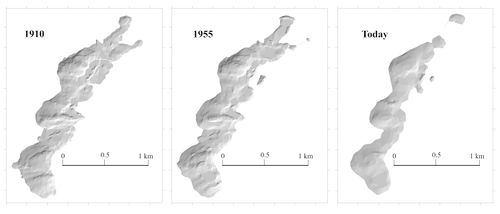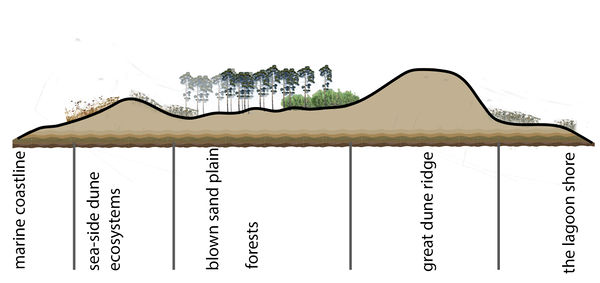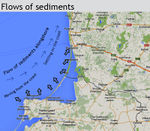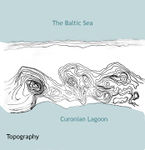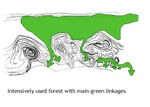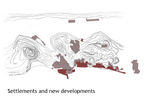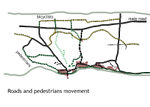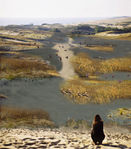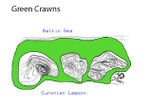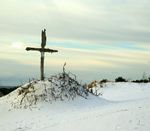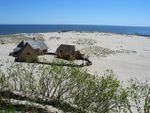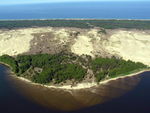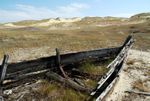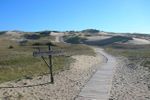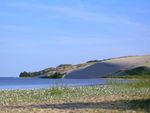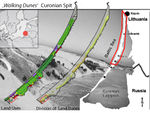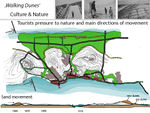Planting Design 2013 Working Group 2 - Case Study C
---> back to group page working group 2
Walking Dunes
| Name | Walking dunes | |
| Location | The Curonian Spit National Park | |
| Country | Lithuania | |
| Authors | Evelina Knyzelyte | |
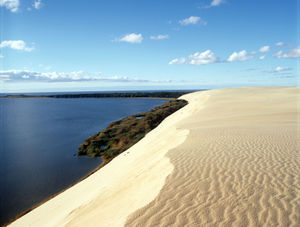
| ||
|
| ||
Rationale: Why is this case interesting?
The Curonian Spit is known as the ‘Pearl of the Baltic’ represents a very unique landscape and numerous species of fauna and flora found in the narrow spindled peninsula. The Spit had been nominated as a mixed site under rich of natural and cultural criteria. In 2000 was included into the UNESCO World Heritage sites as cultural landscape of the world importance, representing the history of dramatic coherence between human and nature.
The history of peninsula show the phenomena of nature as destructive and creating force, the landscape is a result of people activities and interaction within the environment. The wind, water and sand created the peninsula 5000 years ago. Until the 15th century the spit was covered by forests, till people didn’t start to them down. The bared dunes were opened to the wind, which left up to 14 villages under the sand. In 18th century a huge human forces were concentrated in order to save the peninsula.
Currently, the Curonian Spit is a favorite destination between holiday makers, which is also a threat to fragile sandy dunes. Climate change, stronger winds, often storms and human activities are the main threats of dunes decomposition. Preservation and conservation of this unique creature nowadays is under topic between ecologist, biologists, geologists, archeologists and landscape planners.
My personal interest for the site is to present the case of harmonious and disharmonious relation between human and nature, what are the results and raise the question of eco-approach: if the vegetation can improve the dunes stability, avert tourists from sensitive areas and improve the eco cycles.
Author's perspective
From which professional background/perspective are your documenting this case?
My case studied is documented through the analysis of scientific literature, articles in media and personal visitor’s experience. First visit to the site left me with unforgettable experience of spectacular landscape: huge dunes scarping to the water, romantic atmosphere of the old fisherman’s houses and rich diversity of birds’ species. During my Bachelor studies of Architecture, I was introduced to the geomorphological and anthropogenic processes which determined the current value of cultural landscape and inclusion to UNESCO World Heritage sites. I also had the possibility to attend the conference about the preservation trends in the Curonian Spit, protection of species and maintenance of the current shape of dunes. The professor of my university developed the landscape protection plan and is one of the initiatives to save the peninsula. I was using his one of his books (‘Kuršių Nerija National Park’ Jurgis Bučas, 2001) as a tool to understand the situation.
Landscape and/or urban context of your case
- Biogeography, cultural features, overall character, history and dynamics
Biogeography
Physical Geography
The Curonian Spit is a peninsula located between the Baltic Sea and the Curonian Bay on the border of Lithuania and Russia (Kaliningrad region). The northern part of the Spit belongs to the Republic of Lithuania and the southern part belongs to Russia. The area of the Spit is 180 km2. The length is about 97 km. the width of the spit fluctuates from 0,4 to 3,8 km. The total amount of sand in the Spit is about 2 km2.
The Curonian Spit was established in 1991. The administrative center of the Spit is located in the city of Klaipeda. The Curonian Lagoon communicates with the Baltic Sea by a narrow 300 meters channel. Klaipeda city can be reached just by ferry, where an important harbor is placed, serving 7000 ships annually from 50 countries.
Climate
The Spit is unique for its specific climate conditions: between marine and continental, characterized by frequent and intensive changeability of weather and wind. The two-way breeze circulation in summer determines differences of weather between the continental part. In summer, there are noticeably fewer days with strong winds on the Spit, the air temperatures are higher and the humidity is lower.
The average annual air temperature is +7.0oC, absolute minimum is -26.0oC in January and absolute maximum +31.0oC in June. The average annual precipitation is 660 mm; the rainy season is from October till February. High influence on the landscape has wind: approximately 30-40 days are noted than the wind speed exceeds 15 m/s. During the storm, the wind speed can reach 30-40 m/s.
Geology
The Curonian Spit represents the unique example of the landscape formed through the high dynamic of geological and geomorphological processes. In the European scale, the shifting dunes are characterized by great geomorphological diversity. Currently, there are 14 different shifting dune areas along the coast, which has different patterns of geomorphologic processes determined by natural and human processes.
Around 7000 years ago the Curonian Spit was formed of sand grains, which accumulated into a mound and formed peninsula. There are 3 different dunes formation periods defined: 1) intensive dune formation period (5000–4000 years BP); 2) dune stabilization period (from 4000 to 500 years BP), and 3) intensive regeneration period (after 500years BP)
The current dune landscape is a result of human activities and natural forces. The strong dunes decline started in the XVI century because of strong human interventions into the natural processes: massive deforestation determined dunes movement to the Curonian Lagoon, which could come to an end of peninsula. In 19th century humans invoked intellectual, financial and physical resources to save the Curonian Spit. Dunes were strengthened by massive sand grass planting and increasing forests areas. Curonian Spit landscape is unique by its formation, maintenance and usage, it shows a weariless human fight against nature forces, highly influencing people’s lives in peninsula, which was despoiled and created by humans and nature.
Geological 3D Model
History and dynamics
-5000 B.C. - The first inhabitants moved to the Curonian Spit, culture of Narva: fishers and hunters;
-First settlements: fisherman’s villages;
-Archeological founding proves the existence of a Viking trading center;
-At the beginning of military actions the Curonian Spit becomes strategically important linkage between Lithuania and Prussia;
-13th century the conquests of the German Teutonic Order. The Order built a castle on the mainland side: German Memel (in Klaipeda city);
-7 centuries of German domination in the region;
-12th century: ‘Kurenas’ - ancient fishing boats were the picturesque symbol of the Curonian Spit;
-13th century inhabitants were mainly the Baltic tribes of Sambians and Curonians;
-1328 – Curonian Spit was divided into a northern and a southern part. As a border between the Orders’ lands of Memel and the neighboring Sambia.
-The oldest settlement – Nida, first mentioned in 1385;
-1422: the quiet times on the Spit: the first colony of migrants – fishers-kursiai;
-1525-1701: domination of The Grand Duchy of Lithuania;
-XVI century: part of the villages were buried under the sand (now 14 villages are under the sand); internal movement of inhabitants;
-1701-1871: domination of the king from Prussia;
-1871-1918: domination of German emperor;
-19th century: industrial center of the amber supply
-1880: Nida – a meeting point for intellectuals, artists, writers and photographers;
-1929: The Nobel prize winner, German writer, Thomas Mann built his summerhouse there;
-1930s: Nazis seized power in German Reich. Invasion of Jewish holidaymakers, built new summer synagogue;
-1933: the Spit was formally declared a resort. Transformation from fisherman’s villages to touristic villas.
-II World War (1939 - 1945): most of the inhabitants immigrated to Germany. The loss of Curonian Language;
-Soviet era (1945-1990): many new buildings for tourists’ services. Period of extensive use of natural resources without taking into account ecological damage. Suppressed German influence;
-1945: active war fights led to the loss of 800 ha of woods and sand movement;
-1990: the independence of Lithuania Republic.
-1991: the establishment of Curonian Spit National Park, in order to protect the unique ecosystems of the Curonian Spit and Curonian Lagoon.
The historical timeline shows the dynamics of cultures, inhabitants and nature in this area. The area was influenced by Prussian, German and Russian invasions, which led to multi-cultural environment, changing flows of foreign cultures and new tendencies in lifestyle. Still, the most dominant remains origins of Baltic culture. The Curonian Split could present two types of history: history of human and history of nature, with its changes through the human interaction.
The history of people and nature shows several types of interaction:
1) XVI – XVIII centuries show harmonious relationship between people and nature
2) XVIII century represents reckless usage of natural resources: massive deforestation, intensive agriculture and stockbreeding, extraction of coal and pitch lead to the steeped villages under the sand, shoaling of the Curonian Lagoon and the threat of losing the Curonian Spit;
3) Human fight again destructive natural forces:
1805: implementing sandy protection bank to stop sand progress; vegetation used as the sand-fixing agent
1887-1891: implementation of forest cultures on the dunes. In 1605 the woods covered 75% of the territory, in 1700 - only 10% remained, in the XX century - 50 %, now -71%.
Cultural Features
The colorful palette of cultures and people lived there left the significant spur in the Curonian Spit current landscape. Its material value today represents the remains of old fishing settlements with wooden fishermen’s houses with decorative elements, protective structures of sand fortification, 13 old villages buried under the sand. Apart of the ethnographic heritage, The Curonian Spit is significant for its spiritual values to the society.
In 2000 the World Heritage committee included the Curonian Spit to the World Heritage List as a valuable cultural landscape illustrating the dramatic coexistence of human and nature. The Curonian Spit is still developing and playing the important social role in the modern society, related with the traditional living manner and progressive evolutional processes.
It is the unique example of sand dunes landscape, which was saved with the huge efforts with the wisely use of nature power (wind) and humans’ physical resources: there were 600-800 people working at the time on the same area and the current form of the landscape represents human’s inexhaustible fight against natural destructive power and establishment of the cultural landscape, its guideline of sustainable usage, managing and preserving.
Plantation to strengthen the dunes
Landscape character
The Curonian Spit form of landscape is created by the sea, wind and humans. Isolated from the continent and influenced by hard conditions of nature, the Spit represents the unique landscape. Anywhere else we cannot find huge sand dunes planted with European mountain pines, with the old fishermen’s settlements on its base, and the unique atmosphere filled with the musical noise produced by wind, swinging forests, murmur of the sea and friction of the sand grains.
The opening sandy dunes arising up to 40-60 m, the blue mirror-like surface of the Curonian Lagoon on one side and the storming Baltic Sea on the other side creates the picturesque landscape. On this narrow Spit the high diversity of dunes (White Dunes; Grey Dunes) with the combination of the forest greenery and variegated meadows of blooming grasses is found.
Latitudinal areas of landscape types (west to east):
•marine coastline (beach and fore dune ridge);
•blown sand plain (Lith. - palvė) with undulating relief covered with forests or grasses;
•blown-out dunes with the remains of the old dunes;
•forests with pine, broadleaved or black-alder woods or rare forests of birches and willows;
•great dune ridge (segments and forms of dunes are diverse);
•plain(palvė) at the lagoon coast;
•the lagoon shore;
Total area of the Curonian Spit is 16321 ha. Land uses in the whole area:
• Forests 11640 ha - 71.3%
• Sandy areas 4097 ha - 25.1%
• Mires 41 ha - 0.25%
• Meadows and pastures 40 ha - 0.25%
• Inland water bodies 40 ha - 0.25%
• Agricultural lands 6 ha - 0.04%
• Roads 125 ha - 0.77%
• Built up areas 332 ha - 2.03%
Species and Ecosystems
The Curonian Spit represents the diversity of fauna and flora with the array of communities and environments of human intervention. There are about 700 types of plants found on the Spit, 100 were brought to the Spit by humans. The prevailing plants are those, which can adapt well to infertile and unstable sands and pine and spruce forests.
74% of the forested landscape is artificial plantation and only 5% remained from the virgin forests from pre 18th century. Humans planted mountain pines trees on the Large Dunes in order to protect dunes from disruption.
The green covering of the Spit is very fragile and can only be restored after long periods of peace. The Curonian lagoon shore is surrounded by reeds, bulrushes, sedges and meadows, which provide refuge for the waterfowl.
 Types of vegetation cover, in percentage (%)
Types of vegetation cover, in percentage (%)
The species create the unique landscape in the sectional sequence of plants across the Spit:
• seaside beach with Burnet Rose (Rosa pimpinellifolia)
• seaside dune ecosystems with typical endemic species of the Baltic shore: Linaria loseli, Cakile baltica, Tragopogon heterospermus, Anthyllus maritima, Eringium maritimum
• strip of accumulative sand plain covered by Scots' pine (Pinus silvestris) with natural patches of birches and black alders (Betula pendula and Alanus incane)
• chains of shifting barchans interspersed by dune strips fixed with Mugo pine (Pinus mugo) reed beds (Phragmites australis) along the lagoon coast
17 rare and protected plants, listed in Lithuania’s Red Book, can be found on the Curonian Spit. There is a large population of Lunaria redeviva found, Ophioglossum vulgatum, Botrychium simplex, Hippurus vulgaris. Euonymus verrucosa Scop, Sarothamnus scoparius, Hedera helix, Rubus chamaemorus grow here marking the edge of the area of their distribution.
Biological Communities
The vertebrate fauna consists of 338 species, 28 species among them are under the threat of extinction. The rich diversity of birds are noted in the Spit, even 251 species of birds are counted. There are 35 species of mammals in the Spit. The pride of the Curonian Spit is its moose. About 30 are counted as living on the Spit. There are about 200 deer and about 100-120 boars and foxes, squirrels, gray hares, Ussurian dogs are also inhabitants of the Spit.
About 70 fish species inhabit the shores of Baltic Sea. The most common fishes are: the Baltic herring, cod, plaice, and halibut.
Insect species can be found here that are not common anywhere else in Lithuania. One of the best-known moths of the peninsula is Thaumetopoea pinivora, included in the Red Book of Lithuania.
Due to its geographical position and its orientation from the North-east to the South-west the Curonian Spit serves as a “directing line” for the migrating birds of many species. Annually 10 to 20 million migrating birds fly over this 1 km wide strip of land. The considerable part of them stops for a rest and breeding. The most common species of birds using the lagoon are ducks, grebes, coots, gulls, and little terns. Among the passing migratory birds there are a lot of rare and threatened species like: Cygnus bewickii, Anser erythropus, Branta bernicla. The largest colony of herons and cormorants in Lithuania, counting about 1500 nests, is located in the north of Juodkrantė. Rossitten Ornithological station is the first ornithological station in the World, which was established in the Curonian Spit in 1901 to observe the rare species of birds.
Analytical drawings
Please add four analytical sketches/drawings (or montages/schemes) of your case and take the following aspects into account:
- natural dynamic versus cultural framework - in how far do these two forces come together in your case?
- dynamic through the year (you may imagine how the site looks in spring and summer, maybe you also remember it)
- highlight potentials and problems
- Analytical Drawings
Projective drawings
- Please add four projective sketches/drawings (or montages/schemes) for your case and take the following aspects into account:
- How would you like this case to change in the near future? (in 1-2 years)
- And how could it look like in 10-15 years?
- Projective Drawings
Summary and conclusion
One of the most serious problems currently is slow erosion of the dunes, as increasing winds, storms and climate change are real threats to the Curonian Spit. As Curonian Spit is a narrow strip located between water bodies, is very frangible to raised water level and increased winds activity. Another problem is the pressure of tourists to the natural landscape the Curonian Spit attracts around 9700 visitors per day.
The main measures for preventing the Curonian Spit from negative influence of the indicated threats might be the consolidation of the coastal bank with implementing reed grass islands and creating green cycles around the dunes, which would strengthen the base of dunes and create pleasant green spaces which could become a new attraction points to the tourists instead of fragile sand dunes. Sustainable Tourism is the only option to prevent peninsula from negative effects of tourists.
Please summarize your case and give arguments for your projective design (approx 150 words).
Image Gallery
You may add a series of images/photos in addition to the sketches/drawings
- Image Gallery
References
* Please make sure that you give proper references of all external resources used.
* Do not use images of which you do not hold the copyright.
* Please add internet links to other resources if necessary.
'Kursiu Nerijos Nacionalinis Parkas', Jurgis Bucas
'Shifting Dune types' Povilanskas, Riepsas, Armaitiene, Duscinskas
'The Curonian Spit: Identity and Cultural Heritage' EVA PLUHAŘOVA - GRIGIENE
'Curonian Spit' Department of Forest and Protected Areas under the Ministry of Environment of the Republic of Lithuania
www.neringa.lt
www.panoramio.com
About categories: You can add more categories with this tag: "", add your categories


